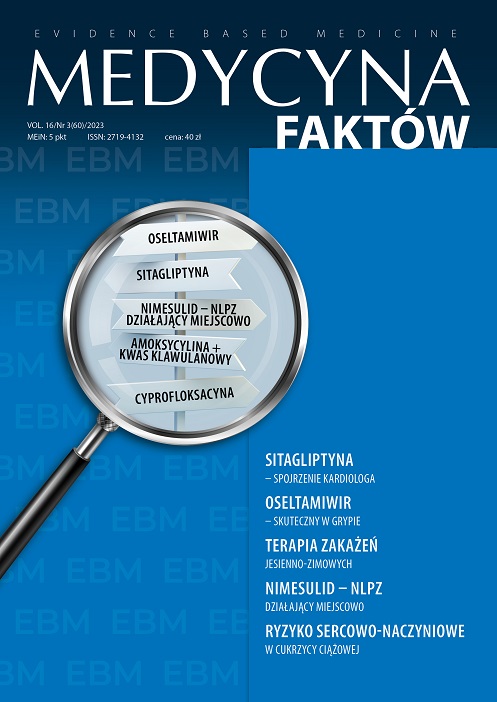Najnowsze doniesienia naukowe dotyczące właściwości i klinicznego zastosowania rosuwastatyny Artykuł przeglądowy
##plugins.themes.bootstrap3.article.main##
Abstrakt
Statyny stanowią fundament terapii zarówno w prewencji pierwotnej, jak i wtórnej chorób sercowo-naczyniowych związanych z miażdżycą. Rosuwastatyna, należąca do tzw. silnych statyn, od lat uznawana w międzynarodowych wytycznych za substancję efektywnie modyfikującą parametry gospodarki lipidowej, stanowi jedną z preferowanych opcji terapeutycznych dla pacjentów wymagających intensywnej terapii statynami, np. po ostrym zespole wieńcowym lub z cukrzycą i wysokim ryzykiem sercowo-naczyniowym. W niniejszym artykule przeanalizowano najnowsze doniesienia naukowe, które uwidaczniają cechy potencjalnie wyróżniające rosuwastatynę na tle innych przedstawicieli tej grupy leków. Należą do nich przede wszystkim silniejsze obniżenie wartości LDL-C we krwi oraz lepszy profil bezpieczeństwa terapii względem atorwastatyny. Ponadto dane z dotychczasowych badań wskazują na bardziej efektywną modyfikację parametrów stanu zapalnego u pacjentów przyjmujących rosuwastatynę.
##plugins.themes.bootstrap3.article.details##
Copyright © by Medical Education. All rights reserved.
Bibliografia
2. Howard JP, Wood FA, Finegold JA et al. Side Effect Patterns in a Crossover Trial of Statin, Placebo, and No Treatment. J Am Coll Cardiol. 2021; 78(12): 1210-22.
3. Ibanez B, James S, Agewall S et al. 2017 ESC Guidelines for the management of acute myocardial infarction in patients presenting with ST-segment elevation: The Task Force for the management of acute myocardial infarction in patients presenting with ST-segment elevation of the European Society of Cardiology (ESC). Eur Heart J. 2018; 39(2): 119-77.
4. Collet JP, Thiele H, Barbato E et al. 2020 ESC Guidelines for the management of acute coronary syndromes in patients presenting without persistent ST-segment elevation. Eur Heart J. 2021; 42(14): 1289-367.
5. Grundy SM, Stone NJ, Bailey AL et al. 2018 AHA/ACC/AACVPR/AAPA/ABC/ACPM/ADA/AGS/APhA/ASPC/NLA/PCNA Guideline on the Management of Blood Cholesterol: Executive Summary: A Report of the American College of Cardiology/American Heart Association Task Force on Clinical Practice Guidelines. Circulation. 2019; 139(25): e1046-e81.
6. Mach F, Baigent C, Catapano AL et al. 2019 ESC/EAS Guidelines for the management of dyslipidaemias: lipid modification to reduce cardiovascular risk. Eur Heart J. 2020; 41(1): 111-88.
7. Rahhal A, Khir F, Orabi B et al. A Comparative Study of High-intensity Rosuvastatin Versus Atorvastatin Therapy Post-acute Coronary Syndrome Using Real-world Data. Curr Probl Cardiol. 2022; 47(7): 100956.
8. Jones PH, Davidson MH, Stein EA et al. Comparison of the efficacy and safety of rosuvastatin versus atorvastatin, simvastatin, and pravastatin across doses (STELLAR* Trial). Am J Cardiol. 2003; 92(2): 152-60.
9. Leiter LA, Rosenson RS, Stein E et al. Efficacy and safety of rosuvastatin 40 mg versus atorvastatin 80 mg in high-risk patients with hypercholesterolemia: results of the POLARIS study. Atherosclerosis. 2007; 194(2): e154-64.
10. Karlson BW, Palmer MK, Nicholls SJ et al. To what extent do high-intensity statins reduce low-density lipoprotein cholesterol in each of the four statin benefit groups identified by the 2013 American College of Cardiology/American Heart Association guidelines? A VOYAGER meta-analysis. Atherosclerosis. 2015; 241(2): 450-4.
11. Stein B, Ward T, Hale G et al. Safety of High-Intensity Statins in the Veteran Population: Atorvastatin 40 to 80 mg Compared With Rosuvastatin 20 to 40 mg. Ann Pharmacother. 2020; 54(5): 405-13.
12. Werida R, Khairat I, Khedr NF. Effect of atorvastatin versus rosuvastatin on inflammatory biomarkers and LV function in type 2 diabetic patients with dyslipidemia. Biomed Pharmacother. 2021; 135: 111179.
13. Hartleb M, Wunsch E, Cichoż-Lach H et al. Postępowanie z chorymi na niealkoholową stłuszczeniową chorobę wątroby (NAFLD) ? rekomendacje dla lekarzy podstawowej opieki zdrowotnej. Opracowane na podstawie zaleceń Polskiej Grupy Ekspertów NAFLD. Lekarz POZ. 2019; 5(5): 323-34.
14. Woźniak E, Broncel M, Niedzielski M et al. The effect of lipid-lowering therapies on the pro-inflammatory and anti-inflammatory properties of vascular endothelial cells. PLoS One. 2023; 18(2): e0280741.
15. Henein MY, Vancheri S, Longo G et al. The Role of Inflammation in Cardiovascular Disease. Int J Mol Sci. 2022; 23(21): 12906.
16. Libby P, Ridker PM, Maseri A. Inflammation and atherosclerosis. Circulation. 2002; 105(9): 1135-43.
17. Crouse JR, 3rd, Raichlen JS, Riley WA et al. Effect of rosuvastatin on progression of carotid intima-media thickness in low-risk individuals with subclinical atherosclerosis: the METEOR Trial. JAMA. 2007; 297(12): 1344-53.
18. Zheng H, Li H, Wang Y et al. Rosuvastatin Slows Progression of Carotid Intima-Media Thickness: The METEOR-China Randomized Controlled Study. Stroke. 2022; 53(10): 3004-13.
